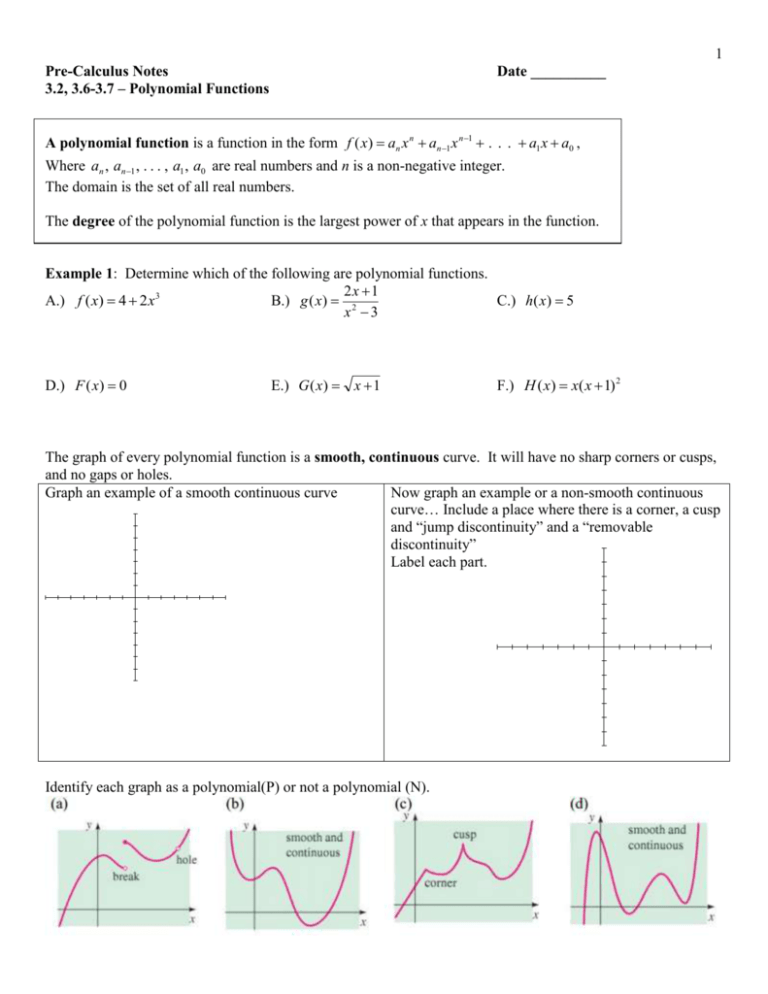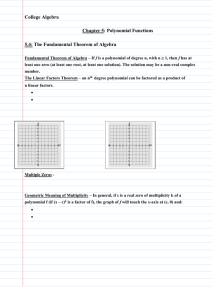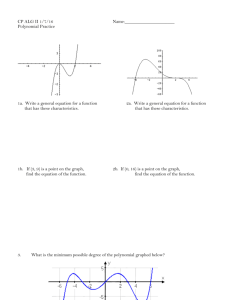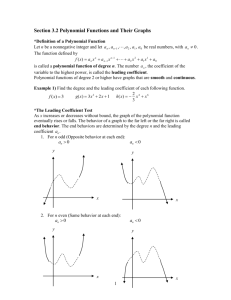Recall: Even and Odd Functions and Symmetry
advertisement

1 Pre-Calculus Notes 3.2, 3.6-3.7 – Polynomial Functions Date __________ A polynomial function is a function in the form f ( x) an x n an 1 x n 1 . . . a1 x a0 , Where an , an1 , . . . , a1 , a0 are real numbers and n is a non-negative integer. The domain is the set of all real numbers. The degree of the polynomial function is the largest power of x that appears in the function. Example 1: Determine which of the following are polynomial functions. 2x 1 A.) f ( x) 4 2 x 3 B.) g ( x) 2 C.) h( x) 5 x 3 D.) F ( x) 0 E.) G ( x) x 1 F.) H ( x) x( x 1) 2 The graph of every polynomial function is a smooth, continuous curve. It will have no sharp corners or cusps, and no gaps or holes. Graph an example of a smooth continuous curve Now graph an example or a non-smooth continuous curve… Include a place where there is a corner, a cusp and “jump discontinuity” and a “removable discontinuity” Label each part. Identify each graph as a polynomial(P) or not a polynomial (N). 2 Power function: A power function of degree n is a function in the form f ( x) ax n , where a is a real number, a 0 , and n is an integer, n > 0. Label the graph with the power function that it is associated with. What happen to the graph as the power increases? Properties of power functions, y x n , n is an even integer The graph is symmetric about the y-axis. The domain is the set of all real numbers. The range is the set of nonnegative real numbers. The graph will always contain the points (0, 0), (1, 1), and (1, 1). As the exponent n increases in magnitude, the graph becomes more vertical when x <1 or x > 1, but for x nearer the origin will flatten out and lie closer to the x-axis. Properties of power functions, y x n , n is an odd integer The graph is symmetric about the origin. The domain and range is the set of all real numbers. The graph will always contain the points (0, 0), (1, 1), and (1, 1). As the exponent n increases in magnitude, the graph becomes more vertical when x <1 or x > 1, but for x nearer the origin will flatten out and lie closer to the x-axis. Use transformations to graph the following functions. Graph the parent power function and then graph using transformations. 1 ( x 2) 4 2 A.) f ( x) 2 x 3 B.) f ( x) 1 A.) f (x) = 2 + x 3 2 B.) f (x) = -2(x - 2)4 3 End behavior: The behavior of the graph of a function for very large or small values of x. f ( x) ax n , for n odd will behave in the same way as f ( x) ax 3 , with different end behaviors, rising on one end and falling on the other. f ( x) ax n , for n even will behave in the same fashion as f ( x) ax 2 , with both ends rising or both ends falling. The following chart may be helpful: Even and Positive Even and Negative Sketch the end behavior of the following graphs. 1. f ( x ) = 6x 3 +8x Odd and Positive 2. f ( x ) = 6x 3 -8x 4 End Behavior: lim f ( x) = End Behavior: lim f ( x) = lim f ( x) = lim f ( x) = x ®¥ Odd and Negative x ®¥ x ® -¥ x ® -¥ End Behavior: the left side goes __________ End Behavior: the left side goes __________ the right side goes _________ the right side goes _________ 3. f ( x ) = -6x 5 +8x 2 End Behavior: lim f ( x) = x ®¥ lim x ® -¥ f ( x) = 4. f ( x ) = 8x 8 -8x 2 End Behavior: lim f ( x) = x ®¥ lim f ( x) = x ® -¥ End Behavior: the left side goes __________ End Behavior: the left side goes __________ the right side goes _________ the right side goes _________ 4 Recall: Even and Odd Functions and Symmetry f is even if for every x in the domain, x is also in the domain and Memorize! f x f x **graph is symmetric with respect to the y-axis Even function: f is odd if for every x in the domain, x is also in the domain and Memorize! f x f x **graph is symmetric with respect to the origin Odd function: EXAMPLES Determine algebraically whether a function is even, odd or neither. Replace every x with –x and simplify; If the result is equal to the original f(x), then the function is EVEN. This means f ( x) f ( x) If the result is the opposite of f(x), then the function is ODD. This means f ( x) f ( x) g x 3x 4 2 First find g ( x) f x 4x3 2x First find f ( x) then a) EXAMPLES b) find f ( x) Determine from a graph whether the function is even, odd or neither. y y y x EVEN Symmetric to x-axis f ( x) f ( x) x x ODD Symmetric to origin f ( x) f ( x) NEITHER No symmetry f ( x) f ( x) Now that we understand what happens when x gets really big (goes to infinity) and get really small (goes to negative infinity). We will now concentrate on what happen in the middle of the graph. We are now going to look at the real zeros of polynomial functions. 5 If f is a polynomial function and r is a real number for which f ( r ) 0 , then r is called a real zero of f, or root of f. If r is a real zero of f, then (r, 0) is an x-intercept of the graph of f. (x – r) is a factor of f. Example: Find a polynomial function of degree 3, whose zeros are 2, 3, and 1. If the same factor occurs more than once, then it is called a multiple factor of the function. The zero obtained from the factor would be a multiple zero. The multiplicity of the zero is the number of times that it occurs. Multiplicity of zeros can aid in graphing the function: If r has multiplicity that is even, then it touches the graph at (r, 0), but does not cross the x-axis. If r has multiplicity that is odd, then it crosses the x-axis at (r, 0). Example: Determine the zeros and the multiplicity of each for the polynomial then graph f ( x) x( x 2) 2 ( x 3) 3 A polynomial function of degree n will have at most n -1 “turning points”, which occur at local maxima or local minima. f ( x) x 2 ( x 3)( x 4) x-int-___________ multiplicity-___________ cross or touches x-int-___________ multiplicity-___________ cross or touches x-int-___________ multiplicity-___________ cross or touches y-int-_________ Symmetry-_________ End Behavior Degree of polynomial _______ lim f (x) = _________ x ®¥ lim f (x) = _________ x ® -¥ Interval above x-axis___________________ Interval below x-axis________________ 6 f ( x) ( x 2) ( x 4) 3 2 x-int-___________ multiplicity-___________ cross or touches x-int-___________ multiplicity-___________ cross or touches x-int-___________ multiplicity-___________ cross or touches y-int-_________ Symmetry-_____________ End Behavior Degree of polynomial _______ lim f (x) = _________ x ®¥ lim f (x) = _________ x ® -¥ Interval above x-axis___________________ Interval below x-axis________________ g ( x) x 2 ( x 2 9)( x 6)2 x-int-___________ multiplicity-___________ cross or touches x-int-___________ multiplicity-___________ cross or touches x-int-___________ multiplicity-___________ cross or touches y-int-_________ Symmetry- _____________ End Behavior Degree of polynomial _______ lim f (x) = _________ x ®¥ lim f (x) = _________ x ® -¥ Interval above x-axis___________________ Interval below x-axis________________ 7 Summary: The graph of a polynomial function, f ( x) an x n an 1 x n 1 . . . a1 x a0 Degree: n Maximum number of turning points: n ─1 At a zero of even multiplicity: graph touches x-axis At a zero of odd multiplicity: graph crosses x-axis Between zeros: graph either above or below x-axis End behavior: graph behaves (using even/odd rules) like the graphs of f ( x) ax 2 or f ( x) ax 3 8 3.6 Real Zeros of a Polynomial Division Algorithm: f ( x) r ( x) or f ( x) q( x) g ( x) r ( x) q( x) g ( x) g ( x) Dividend quotient divisor remainder where r (x) is either the zero polynomial or a polynomial with degree < that of g(x). If the remainder is zero, then we say that f (x) divides evenly by g(x). Remainder Theorem: If f (x) is divided by (x – c), then the remainder is f (c). There are two ways that we find real zeros of polynomials… We either use synthetic division (if we have a linear binomial) or long division. Example 9: Use synthetic division to divide: (3x3 2 x 2 4) ( x 2) . Example 10: Use long division to divide: (3x3 2 x 2 4) ( x 2) . 9 Example 11: Use the Remainder Theorem and synthetic division to find the value of the function at the indicated values. f ( x) x 4 2 x 3 4 x 2 3 x 1 A.) f (3) B.) f (─2) Factor Theorem: Given a polynomial function f (x), x ─ c is a factor of f (x) if and only if f (c) = 0. This theorem has two parts: If f (c) = 0, then x ─ c is a factor of f (x). If x ─ c is a factor of f (x), then f (c) = 0. Example 12: Use the Factor Theorem to determine whether the function, f ( x) 4 x3 5 x 2 1 has the given factor A.) x +2 B. x ─ 1 Theorem: A polynomial function of degree n will have no more than n zeros. Rational Zeros Theorem: If f (x) is a polynomial function with degree 1 or higher and integer coefficients, p then any rational zeros of f must be in the form , where p is a factor of the constant term and q is a factor of q the leading coefficient. Example 13: A.) List the possible rational zeros of f ( x) 2 x3 11x 2 7 x 6. B.) Use synthetic division to find one of the rational zeros of the function. C.) Use factoring or quadratic formula to find the remaining zeros. 10 D.) Use the zeros to write the factors of the polynomial function. The Intermediate Value Theorem: Let a and b be real numbers such that a < b. If f is a polynomial function such that f(a) and f(b) are of opposite sign, then there is at least one zero of f between a and b. 7. Use the I.V.T. to show that the polynomial function has a zero in the given interval. f ( x) 3x 3 10 x 9; [3, 2]







